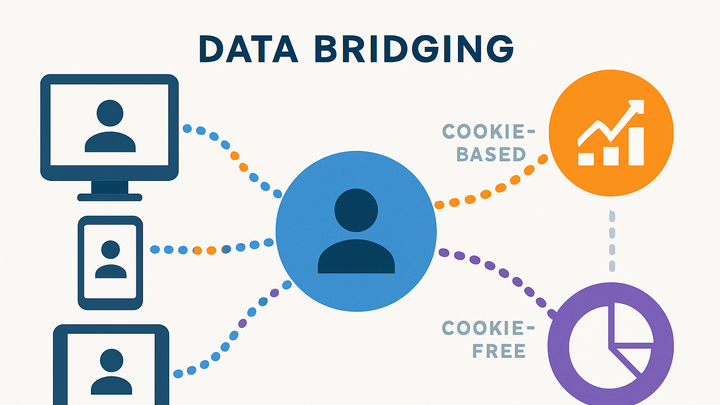Published on 2025-06-27T19:44:54Z
What is Data Bridging? Examples of Data Bridging.
Data Bridging in analytics is the process of linking and unifying user data across disparate sources, sessions, and devices into a single, comprehensive view. This technique addresses the fragmentation of user journeys caused by multiple devices (desktop, mobile, tablet), browsers, and platforms. By mapping identifiers—such as cookies, device IDs, and user IDs—and utilizing both cookie-based and cookie-free strategies, organizations can achieve accurate attribution, deeper user insights, and personalized experiences. Solutions like Google Analytics 4 employ first-party cookies and a robust Measurement Protocol for bridging, while PlainSignal leverages privacy-centric, cookie-free signals. Implementing Data Bridging enhances reporting accuracy and helps businesses navigate evolving privacy regulations like GDPR and CCPA.
Data bridging
Unifying user data from multiple devices and platforms by mapping identifiers to create a cohesive analytics view.
Definition and Purpose
Explore what Data Bridging means in analytics, why it matters, and the key challenges it addresses.
-
Cross-device and cross-platform tracking
Data Bridging allows organizations to recognize and track a single user across multiple devices and platforms, eliminating fragmented session data.
-
Challenges without bridging
Without Data Bridging, user interactions on separate devices remain siloed, leading to inaccurate session counts and attribution gaps.
-
Unified user profiles
Bridging creates consolidated profiles by merging identifiers, enabling personalized experiences and accurate lifetime value calculations.
-
-
Cookie-based vs. cookie-free bridging
Traditional bridging relies on cookies and user-ID, while modern approaches leverage server-side tracking and browser signals to maintain user continuity without cookies.
-
Cookie-based
Uses first-party cookies and user‐ID features in platforms like GA4 to link sessions when users log in.
-
Cookie-free
Employs device fingerprinting, hashed identifiers, or signal matching as seen in PlainSignal to preserve tracking in a privacy-compliant way.
-
How Data Bridging Works
A technical overview of the methods and algorithms involved in unifying user data.
-
Identifier mapping
Bridging maps multiple identifiers (cookies, device IDs, login IDs) to a master user ID, often through hashing or encryption.
-
Data collection
Collect consistent identifiers across touchpoints via scripts or SDKs.
-
Hashing & encryption
Protect privacy by hashing identifiers before storage and matching.
-
-
Data stitching techniques
After mapping, events and sessions are stitched into a continuous timeline to reflect the complete user journey.
-
Session stitching
Combines events across sessions even after cookie resets.
-
Event de-duplication
Ensures the same event isn’t counted twice when identifiers overlap.
-
Use Cases and Examples
Practical implementations of Data Bridging using popular analytics SaaS products.
-
Implementing with google analytics 4
GA4’s User-ID feature and Measurement Protocol enable bridging logged-in user data across platforms and sessions.
-
User-id setup
Assign your internal user ID to the GA4 user_id parameter for consistent tracking.
-
Cross-platform reporting
Use the GA4 cross-platform reports to analyze unified user journeys.
-
-
Implementing with PlainSignal
PlainSignal offers cookie-free simple analytics that bridges data using privacy-friendly signals. Include the following snippet in your site’s <head> to start bridging:
-
Sample tracking code
<link rel="preconnect" href="//eu.plainsignal.com/" crossorigin /> <script defer data-do="yourwebsitedomain.com" data-id="0GQV1xmtzQQ" data-api="//eu.plainsignal.com" src="//cdn.plainsignal.com/plainsignal-min.js"></script>
-
Benefits and Considerations
Key advantages and potential caveats when implementing Data Bridging.
-
Improved attribution accuracy
Bridging ensures that conversions and interactions are attributed to the correct user, improving ROI calculations and marketing performance analysis.
-
Privacy and compliance
While bridging enhances analytics depth, it must adhere to GDPR, CCPA, and other privacy laws, requiring user consent and secure data handling.
